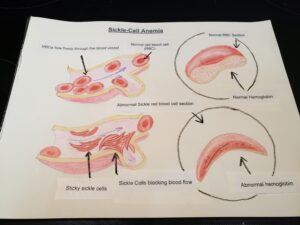My project picture portrays the differences between normal red blood cells and sickle cells. It shows how normal red blood cells are rounded and flow easily and freely through blood vessels. It also shows how sickle cells are crescent shaped, sticky, and how they can cause blockages in the blood vessels and do not flow very well.

This project covers sickle-cell disease, which is an inherited blood disorder due to a genetic mutation in beta globin (a protein found in hemoglobin). The mutation itself is simple, affecting only one base pair (where there is a thymine between two guanines, rather than an adenine). Of course, this means that the DNA transcription is incorrect as well, and the product is a mutant protein.
The visual representation demonstrates the difference between normal red blood cells and sickle cells, and between the hemoglobin in each. It clearly displays the problem caused by “sticky” sickle cells, where blood flow is blocked and the cell cannot continue normal growth or functioning. Since healthy red blood cells are in charge of oxygenating various tissues of the body, it isn’t surprising that this disease is life-threatening.
There are different forms of sickle-cell disease, and they differ in severity. For instance, a person who inherits one sickle cell (S) gene from one parent but a normal gene from the other is said to have the sickle cell trait. They may pass it on to their children, but their life is not usually complicated by any severe signs of disease. There are several milder forms of the disease, but perhaps the most familiar form is the most severe. Sickle cell amenia affects people who inherit an S gene from each of their parents, and therefore have a much higher propensity to sickled red blood cells.
Lisa did a lovely job on her project, and the illustrated cells are very well done. Her essay was informative and engaging, as well. I would’ve loved the addition of the typical symptoms of a person with sickle-cell disease, and some discussion of treatments as well, but I found everything else about this project quite satisfactory. Thanks for sharing, Lisa!